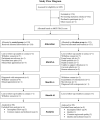The effects of combined amplitude and high-frequency vibration on physically inactive osteopenic postmenopausal women
- PMID: 36160873
- PMCID: PMC9491321
- DOI: 10.3389/fphys.2022.952140
The effects of combined amplitude and high-frequency vibration on physically inactive osteopenic postmenopausal women
Abstract
Purpose: To evaluate whole-body vibration (WBV) osteogenic potential in physically inactive postmenopausal women using high-frequency and combined amplitude stimuli. Methods: Two-hundred fifty-five physically inactive postmenopausal women (55-75 years) with 10-year major osteoporotic fracture risk (3%-35%) participated in this 18-month study. For the first 12 months, the vibration group experienced progressive 20-min WBV sessions (up to 3 sessions/week) with rest periods (30-60 s) between exercises. Frequencies (30-50 Hz), with low (0.2-0.4 mm) and high (0.6-0.8 mm) amplitude stimuli were delivered via PowerPlate Pro5 platforms producing accelerations of (0.75-7.04 g). The last 6 months for the treatment group were a follow-up period similar to control. Serum bone remodelling markers [C-terminal crosslinked telopeptide of type-1 collagen (CTX), procollagen type-1 N-terminal propeptide (P1NP), bone alkaline phosphatase (BAP) and sclerostin] were measured at fasting. CTX and P1NP were determined by automated chemiluminescence immunoassay, bone alkaline phosphatase (BAP) by automated spectrophotometric immunoassay, and sclerostin by an enzyme-immunoassay. Bone mineral density (BMD) of the whole-body, proximal femur and lumbar vertebrae was measured by dual-energy X-ray absorptiometry (DXA). Bone microarchitecture of the distal non-dominant radius and tibia was measured by high-resolution peripheral quantitative computed tomography (HR-pQCT). Results: Femoral neck (p = 0.520) and spine BMD (p = 0.444) failed to improve after 12 months of WBV. Bone macro and microstructural parameters were not impacted by WBV, as well as estimated failure load at the distal radius (p = 0.354) and tibia (p = 0.813). As expected, most DXA and HR-pQCT parameters displayed age-related degradation in this postmenopausal population. BAP and CTX increased over time in both groups, with CTX more marginally elevated in the vibration group when comparing baseline changes to month-12 (480.80 pmol/L; p = 0.039) and month-18 (492.78 pmol/L; p = 0.075). However, no differences were found when comparing group concentrations only at month-12 (506.35 pmol/L; p = 0.415) and month-18 (518.33 pmol/L; p = 0.480), indicating differences below the threshold of clinical significance. Overall, HR-pQCT, DXA bone parameters and bone turnover markers remained unaffected. Conclusion: Combined amplitude and high-frequency training for one year had no ameliorating effect on DXA and HR-pQCT bone parameters in physically inactive postmenopausal women. Serum analysis did not display any significant improvement in formation and resorption markers and also failed to alter sclerostin concentrations between groups.
Keywords: age-related bone loss; dose-response; fracture risk; postmenopausal women; whole-body vibration.
Copyright © 2022 Fernandez, Pasqualini, Locrelle, Normand, Bonneau, Lafage Proust, Marotte, Thomas and Vico.
Conflict of interest statement
The authors declare that the research was conducted in the absence of any commercial or financial relationships that could be construed as a potential conflict of interest.
Figures



References
LinkOut - more resources
Full Text Sources
Research Materials

